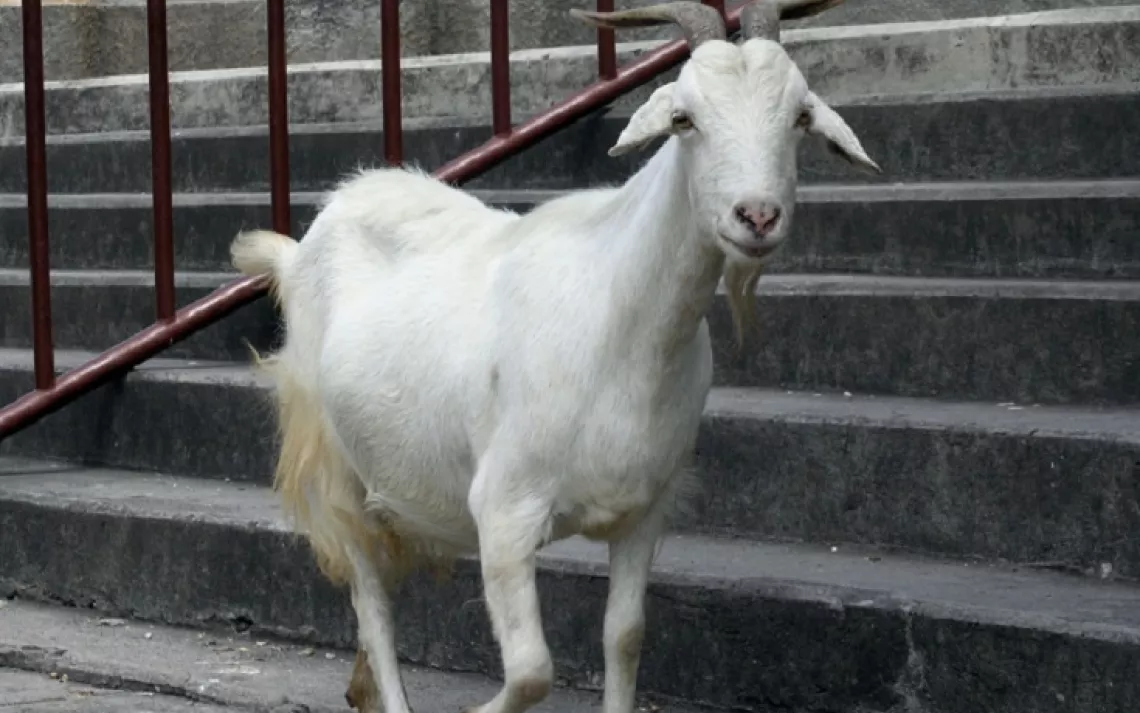Goats: Coming Soon to a City Near You

The story of the nation’s drawn out economic recovery keeps getting longer, and nowhere are enduring impacts of the recession more vivid than Detroit. But the city’s Brightmoor neighborhood hopes to bring both financial and ecological revitalization to their community with some unusual helpers: goats.
“Much of Brightmoor is basically a dump site. There’s years’ of layers of garbage,” Mark Spitznagel told Sierra recently. Spitznagel is a hedge fund manager who provided Brightmoor with goats from his farm in northern Michigan. The plan was to have goats munch away the vegetation that obstructs alleys and obscures mounds of trash, with the goat herders’ daily presence preventing further dumping. Once cleared, the ground would be put to agricultural use. Spitznagel worked closely with Brightmoor community leaders to develop the project and identify locals who could be hired as goat keepers.
Unfortunately, the group failed to seek permission from the city, which has an ordinance banning farm animals. The goats arrived in Brightmoor on a Thursday in June, and by Saturday the city had sent them packing. However, Spitznagel and his community partners haven’t given up hope that goats will someday bring sustainable growth to this struggling neighborhood.
Spitznagel envisions a holistic system of urban agriculture that could address a host of social and environmental justice issues in American cities, and goats stand at the core of his solution. “Modern agriculture is about mining the soil for maximum, immediate productivity,” said Spitznagel. “Yet soil remains our greatest long-term asset.” Goats protect that asset sustainably. Not only can they efficiently clear land for agricultural production, eliminating the need for chemicals and heavy machinery, but they also provide natural fertilizer and their hoof action makes the soil healthier over time. As food production moves farther and farther from those who consume it, creating food deserts in urban communities like Brightmoor, Spitznagel wants to give consumers more control over where their meals come from.
“Urban farming means more to Brightmoor because of how this community is clawing its way back,” he said. “This is a community that for a number of years has had its own sort of urban farming entrepreneurialism going on, under the radar. You’ll find chickens and a random goat here and there.”
While officials in Detroit remain determined to butt the goats out of city limits, other municipal governments have embraced the ravenous ruminants. In Boulder, Colorado, the Parks and Recreation Department has employed goats as weed controllers for over a decade. Joy Master, a conservation ecologist for the department, noted that because grazing suppresses weeds, rather than eradicating them entirely, goats require a multi-year commitment for best results.
Oakland, California, is fighting fire with goats. They’re the most efficient way to clear large areas of vegetation that would contribute to the spread of wildfires, explained Vince Crudele, vegetation management supervisor at the Oakland Fire Prevention Bureau. Oakland’s drought-parched hillsides crawl with goats chowing down on low-lying plants. Across the West, fire season is lengthening, and fires are eating up greater swathes of land, so preventatory measures are increasingly crucial.
Cities often bring in goats to avoid using chemicals and heavy machinery that would create air, water, and noise pollution unacceptable in dense urban areas. Moreover, the goat’s mechanical alternative, the bulldozer, often puts endangered species in jeopardy. Goats are more interested in gorging on weeds than flattening snakes and birds.
“We’re protecting humans by putting the goats in,” said Crudele. Goats nimbly access steep, rocky inclines treacherous to two-legged workers, and they aren’t afraid to wade through seas of poison oak—in fact, it’s just another weedy delicacy on the grazer’s menu.
Both Master and Crudele report strong community support for the city’s goats. Master’s department receives calls from people asking for the goats’ deployment location so they can enjoy the spectacle. Crudele believes goats offer his city value that goes beyond fire prevention. “We have families going there to watch the goats graze. That’s quite a contrast from other parts of Oakland and the things that happen here.”
While the goats of Oakland and Boulder will keep munching away as long as city budgets allow, the future of goats in Brightmoor is less certain. But Spitznagel believes Detroit is uniquely positioned to be the birthplace of an agricultural renaissance, because its abandoned lots endow it with plenty of cultivable land, and the city is teeming with people in need of work. Some Brightmoor residents want to adopt the goat as a neighborhood mascot that symbolizes their determination, intelligence, and resilience. Like the goat, the Brightmoor neighborhood might look scruffy on the outside. “What some see as a blight,” Spitznagel said, “we see as a great resource.”
 The Magazine of The Sierra Club
The Magazine of The Sierra Club



